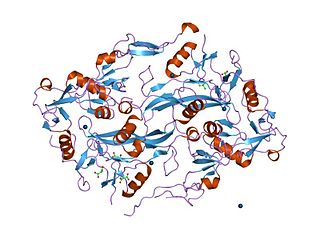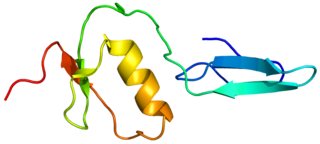Inhibin, beta B, also known as INHBB, is a protein which in humans is encoded by the INHBB gene. [5] [6] INHBB is a subunit of both activin and inhibin, two closely related glycoproteins with opposing biological effects.
Inhibin, beta B, also known as INHBB, is a protein which in humans is encoded by the INHBB gene. [5] [6] INHBB is a subunit of both activin and inhibin, two closely related glycoproteins with opposing biological effects.
Inhibins are heterodimeric glycoproteins composed of an α subunit (INHA) and one of two homologous, but distinct, β subunits (βA or βB, this protein). mRNA for the two subunits has been demonstrated in the testes of adult rats. [7] Inhibin can bind specifically to testicular interstitial cells throughout development and may be an important regulator of Leydig cell testosterone production or interstitial cell function. [8]
The inhibin beta B subunit joins the α subunit to form a pituitary FSH secretion inhibitor. Inhibin has been shown to regulate gonadal stromal cell proliferation negatively and to have tumour-suppressor activity. In addition, serum levels of inhibin have been shown to reflect the size of granulosa-cell tumors and can therefore be used as a marker for primary as well as recurrent disease. Because expression in gonadal and various extragonadal tissues may vary severalfold in a tissue-specific fashion, it is proposed that inhibin may be both a growth/differentiation factor and a hormone.
Furthermore, the beta B subunit forms a homodimer, activin B, and also joins with the beta A subunit to form a heterodimer, activin AB, both of which stimulate FSH secretion. [6]
Sections of testicular tissue from rat revealed positive immunoreactivity against anti-inhibin intensely appeared in Leydig cells. [9] In adult animals, binding of 125I inhibin was localized primarily to the interstitial compartment of the testis. [8] Also, Jin et al., (2001) reported that Leydig cells showed strong positive staining for the inhibin βA subunit in pigs testis. [10]
In situ ligand binding studies have shown that 125I inhibin βA binds specifically to Leydig cells throughout rat testis development. These results suggest that inhibin has been considered as a regulator of Leydig cell differentiated function. [11] [12] Recently, additional inhibin specific binding proteins were identified in inhibin target tissues, including pituitary and Leydig cells. [13] [14] From these receptors betaglycan (the TGF-β type III receptor) and InhBP/p120 (a membrane-tethered proteoglycan) were identified as putative inhibin receptors and they are all present in Leydig cells. However, a faint positive reaction was detected in Leydig cell cytoplasm in rats treated with anise oil. [9] This may be related to the damaged Leydig cells, as a result of the decreasing of inhibin expression. This may be related to its content of safrole.
INHBB gene has been observed progressively downregulated in Human papillomavirus-positive neoplastic keratinocytes derived from uterine cervical preneoplastic lesions at different levels of malignancy. [15] For this reason, INHBB is likely to be associated with tumorigenesis and may be a potential prognostic marker for uterine cervical preneoplastic lesions progression. [15]

Follicle-stimulating hormone (FSH) is a gonadotropin, a glycoprotein polypeptide hormone. FSH is synthesized and secreted by the gonadotropic cells of the anterior pituitary gland and regulates the development, growth, pubertal maturation, and reproductive processes of the body. FSH and luteinizing hormone (LH) work together in the reproductive system.

The luteinizing hormone/choriogonadotropin receptor (LHCGR), also lutropin/choriogonadotropin receptor (LCGR) or luteinizing hormone receptor (LHR), is a transmembrane receptor found predominantly in the ovary and testis, but also many extragonadal organs such as the uterus and breasts. The receptor interacts with both luteinizing hormone (LH) and chorionic gonadotropins and represents a G protein-coupled receptor (GPCR). Its activation is necessary for the hormonal functioning during reproduction.

Follistatin, also known as activin-binding protein, is a protein that in humans is encoded by the FST gene. Follistatin is an autocrine glycoprotein that is expressed in nearly all tissues of higher animals.

Activin receptor type-1B is a protein that in humans is encoded by the ACVR1B gene.

Activin receptor type-2A is a protein that in humans is encoded by the ACVR2A gene. ACVR2A is an activin type 2 receptor.
The activin type 2 receptors belong to a larger TGF-beta receptor family and modulate signals for transforming growth factor beta ligands. These receptors are involved in a host of physiological processes including, growth, cell differentiation, homeostasis, osteogenesis, apoptosis and many other functions. There are two activin type two receptors: ACVR2A and ACVR2B.

Activin receptor type-2B is a protein that in humans is encoded by the ACVR2B gene. ACVR2B is an activin type 2 receptor.

The steroidogenic factor 1 (SF-1) protein is a transcription factor involved in sex determination by controlling the activity of genes related to the reproductive glands or gonads and adrenal glands. This protein is encoded by the NR5A1 gene, a member of the nuclear receptor subfamily, located on the long arm of chromosome 9 at position 33.3. It was originally identified as a regulator of genes encoding cytochrome P450 steroid hydroxylases, however, further roles in endocrine function have since been discovered.

Inhibin, beta A, also known as INHBA, is a protein which in humans is encoded by the INHBA gene. INHBA is a subunit of both activin and inhibin, two closely related glycoproteins with opposing biological effects.

Thyroid hormone receptor beta (TR-beta) also known as nuclear receptor subfamily 1, group A, member 2 (NR1A2), is a nuclear receptor protein that in humans is encoded by the THRB gene.

Inhibin, alpha, also known as INHA, is a protein which in humans is encoded by the INHA gene.

Relaxin/insulin-like family peptide receptor 2, also known as RXFP2, is a human G-protein coupled receptor.

Follitropin subunit beta also known as follicle-stimulating hormone beta subunit (FSH-B) is a protein that in humans is encoded by the FSHB gene. Alternative splicing results in two transcript variants encoding the same protein.

Follistatin-related protein 3 is a protein that in humans is encoded by the FSTL3 gene.
Testicular Immunology is the study of the immune system within the testis. It includes an investigation of the effects of infection, inflammation and immune factors on testicular function. Two unique characteristics of testicular immunology are evident: (1) the testis is described as an immunologically privileged site, where suppression of immune responses occurs; and, (2) some factors which normally lead to inflammation are present at high levels in the testis, where they regulate the development of sperm instead of promoting inflammation.

Inhibin beta C chain is a protein that in humans is encoded by the INHBC gene.

Luteinizing hormone subunit beta also known as lutropin subunit beta or LHβ is a polypeptide that in association with an alpha subunit common to all gonadotropin hormones forms the reproductive signaling molecule luteinizing hormone. In humans it is encoded by the LHB gene.

Thyroid stimulating hormone, beta also known as TSHB is a protein which in humans is encoded by the TSHB gene.

Activin and inhibin are two closely related protein complexes that have almost directly opposite biological effects. Identified in 1986, activin enhances FSH biosynthesis and secretion, and participates in the regulation of the menstrual cycle. Many other functions have been found to be exerted by activin, including roles in cell proliferation, differentiation, apoptosis, metabolism, homeostasis, immune response, wound repair, and endocrine function. Conversely, inhibin downregulates FSH synthesis and inhibits FSH secretion. The existence of inhibin was hypothesized as early as 1916; however, it was not demonstrated to exist until Neena Schwartz and Cornelia Channing's work in the mid-1970s, after which both proteins were molecularly characterized ten years later.

3β-Androstanediol, also known as 5α-androstane-3β,17β-diol, and sometimes shortened in the literature to 3β-diol, is an endogenous steroid hormone and a metabolite of androgens like dehydroepiandrosterone (DHEA) and dihydrotestosterone (DHT).
This article incorporates text from the United States National Library of Medicine, which is in the public domain.